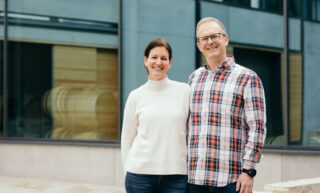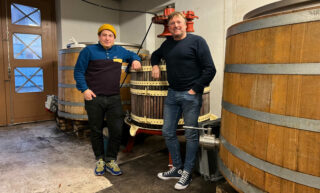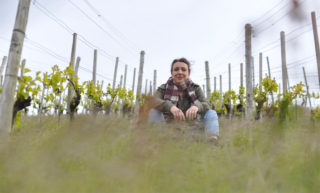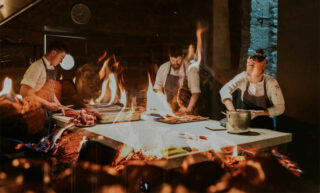With a third generation of fungus resistant grapes in development, are we going to see a breakthrough in the spread of so-called PIWIs? Is the quest for an alternative for disease prone pinot noir and other traditional varieties finally going to bear fruit? Leading Swiss institutions, breeders, nurseries and wineries are surely making progress.
With a third generation of fungus-resistant hybrid wine grapes in development, are we poised for a breakthrough in the spread of so-called PIWIs? Will the quest for an alternative to disease-prone Pinot Noir finally bear fruit? Swiss researchers, breeders, nurseries, and winemakers are at the forefront of this effort.
For an increasing number of vintners, traditional grape growing with seven to 12 rounds of spraying annually has become unsustainable. For some, organic farming
isn’t the answer. Because organic agents work superficially and wash off with rain,
they must be applied more frequently. This requires more labor and more passes through the vineyard, leading to higher CO2 emissions, as well as greater soil compaction and higher costs. The ultimate solution would be grape varieties that are resistant to the feared fungal diseases oidium and peronospora, and don’t require any form of synthetic fungicide.
Fungus-resistant varieties, known as PIWIs (from the German word pilzwiderstandsfähig) are finding popularity beyond humid, cooler-climate zones. Even in countries with long winemaking histories like Switzerland, they are gaining ground. Although Swiss efforts to breed PIWIs are barely 40 years old, the nation is now a leader in this trend, perhaps not in the number of newly developed PIWIs, but certainly in terms of vineyard surface planted to them — 3 percent according to 2021 data. In some German-speaking cantons that percentage stands considerably higher (in Thurgau and Basel around 9%), yet in Waadt and Wallis, Switzerland’s most important — and climatically more forgiving — wine regions, the acreage remains low.
Mother Vines. Photo Credit: Weingut Lenz
PIWIs – why Switzerland?
The motivation to plant PIWIs in Switzerland derives partly from the necessity to deal with wet, fungi-stimulating conditions, especially in the northern parts of the country known as Deutschschweiz, and in the warm, humid southern canton of Ticino, but also from an ambition to farm sustainably. A survey among Bio Suisse vintners in 2016 suggests that organic wineries in Switzerland have more than 25 percent of their vineyards planted to PIWIs.
With the notable exception of Ticino, most cantons allow PIWIs to be made into appellation wines. Zürich and Thurgau allow a whopping 40 and 30 PIWI varieties, respectively. This is obviously an encouragement for vintners to plant them. In Austria, the approach is more cautious. Currently, there are five PIWIs allowed for quality wine, but while the European Union accepted hybrids for making appellation wines in 2021, only two DACs — Neusiedlersee and Rosalia — actually currently permit them.
Although a nationwide referendum held in 2021 in Switzerland aimed at banning the use of synthetic pesticides in the country didn’t pass, Rodrigo Banto, head oenologist at Cave de la Côte, a cooperative in Waadt, sees the plebiscite as a sign of shifting sentiments. He also believes that consumers perceive all spraying — organic and synthetic — as negative. So his bet is on PIWIs, which require few if any fungicide treatments.
However, a variety of factors may be holding vintners back: tradition, for instance, the focus on indigenous varieties in Wallis; the commercial success of traditional varieties such as Chasselas in Waadt and Pinot Noir in the Drei-Seen-Region; a lack of public awareness; adverse flavor associations; and, in some places, climate, such as the Föhn wind in Graubünden, which dries the vines quickly.
Building resistance
Since the 1960s, Jean-Laurent Spring, head of the grape breeding program at Agroscope, the Swiss federal agency for research and development for the agricultural sector, has been focused on crossing European (vitis vinifera) varieties. But because the main fungal diseases are not native to Europe, the vinifera varieties and their crosses have no built-in genetic resistance.
The second wave of PIWI development focused on crossing vinifera with naturally resistant American and Asian varieties. Divico, a red variety with 74 hectares spread across Switzerland, and Divona, a white variety covering just 8 hectares so far, are Agroscope’s biggest successes. “These varieties typically have single- or double-gene resistance against fungal diseases,” explains Katie Mackie-Haas, an American scientist and research group lead at Agroscope. “This means that resistance isn’t perfect. Both Divico and Divona have good resistance against powdery mildew, but their resistance against downy mildew is somewhat lower, and both remain sensitive to black rot.” Three rounds of spraying per year, organic or systemic, are still required.
To further decrease sensitivity to fungal diseases, a third phase of PIWI development focusing on multi-gene resistance is now underway.
Variety Cal 32-7 with visitor. Photo credit: Weingut Lenz
Testing, testing
A big challenge in the development of PIWIs is taste. Many have organoleptic properties that producers and consumers alike struggle with. The trick, researchers say, is to minimize the American or Asian part of the crossing. Successful PIWIs, therefore, are the result of multiple rounds of crossing.
Even with a limited amount of genetic material from American or Asian species, testing a new variety in the cellar is crucial, especially when the goal is the holy grail — varieties that can compete with Chardonnay and Pinot Noir, as Thierry Wins, Agroscope’s winemaker, says. Not an easy task when consumers associate PIWIs with unusual flavors and, in some cases, a lack of consistency, length, or body.
Agroscope, which started developing PIWIs in the 1990s, follows a strict cellar protocol, Wins and Mackie-Haas point out. To speed up the development process, from initial crossing to commercialization, micro-vinification starts after the first harvest. The crossings that have shown the best results in the vineyard are eligible, even before long-term resistance against fungal diseases is established.
To maximize comparability there are just two vinification scripts, one for whites and one for reds. The wines undergo an initial sensory test by a panel of Agroscope employees focusing on basic sensory aspects of the wines: faults, acidity, minerality, fruitiness, complexity, tannins, length, etc.
To take vintage variation into account, the entire cycle is repeated for several years. Furthermore, Agroscope leases vineyard parcels in several parts of the country to experiment with the varieties’ potential in different locations.
The PIWIs that eventually show the best results, both in the vineyard and after micro-vinification, proceed to a second phase of vinification tests. More vines are planted, and wines are made in larger quantities. Experiments are made with various vessel types and yeasts, with or without lees work, cold maceration, skin fermentation, etc. Currently, about ten varieties are being tested, among them Divona, Divico, Muscaris, Cal 1-36, Cal 1-28, Cabernet Jura, Sauvignac, and Cabernet Blanc.
Microvinification. Photo credit: Weingut Lenz
A breeder, a nursery, an experimental garden
But Agroscope has competition. Cal 1-28, Cal 1-36, Sauvignac, Cabernet Jura, and Cabernet Blanc, for example, are all the creations of Valentin Blattner, a private breeder from the village of Soyhières in northwestern Switzerland. As at Agroscope, he focuses on PIWIs with resistance against multiple fungal diseases. His collaborators, Philippe Borioli and Roland Lenz, play key supporting roles. Borioli runs a nursery with a large collection of so-called Mutterstöcken, or mother vines — the vines that are grown from the pips of a new crossing, the best of which he propagates by grafting branches onto American rootstocks. Lenz manages an experimental vineyard for new PIWIs with a micro-vinification of the most promising ones. He is also the president of the Swiss branch of PIWI International.
Wanted: high yields, good intensity
Lenz’s winemaking philosophy can be described as light touch. Most of his wines, including the micro-vinifications, are spontaneously fermented; the only additions he uses are bentonite and sulphur, the latter only after filtration, just before bottling.
To maximize the positive environmental impact of PIWIs, he is convinced that he first needs to win over casual wine drinkers and therefore prefers high-yielding varieties. He dismisses with a chuckle my objection that low-yielding vines are supposed to make more intense wines. “We are searching for a high-yielding PIWI with good flavor intensity.” His logic: if you can harvest more kilos of grapes per hectare, you use less resources per liter.
Challenges
Making wine from PIWI varieties brings specific challenges, Lenz explains. Because PIWIs usually have somewhat thicker skins, their skin-to-pulp ratio is higher and the yield 5 to 10 percent lower. A skilled winemaker can reduce that loss, Lenz continues, through a short maceration of 12 to 36 hours.
As red wine grapes are fermented on the skins anyway, yield loss is less of a problem. The challenge here is the large amount of antioxidants the grape skins contain. Ripening in inert stainless steel containers can lead to unwanted reductive notes. Micro-oxidation through the use of wooden barrels can prevent this.
Thierry Wins from Agroscope adds that some red PIWIs, like Cabernet Jura, need to be pressed sooner than other varieties, because of their tendency to develop over-powering floral aromas.
Antoine Kaufmann from the Demeter-certified winery KLUS177 in Aesch (Basel-Landschaft) has observed a lack of length with red PIWIs in particular. His strategy thus far has been to blend. A bit of Pinot Noir with Cabernet Jura, for instance, adds length and complexity. Although he thinks Souvignier Gris has potential as a monovarietal, for now he blends it with Räuschling.
Asked if he recognizes the (perceived) issues often associated with PIWI wines, Lenz answers that these typically occurred with older PIWI varieties. Most importantly, he points out, vintners need time to understand a new variety’s do’s and don’ts. With Riesling and Spätburgunder, for instance, generations of vintners have built centuries of experience. The current state of winemaking should allow for the benefits of the new PIWIs sooner.
After tasting one wine each from the first vintage of four new “multi-gene” PIWIs, with cryptic names such as 6-070 and 2001-29, the traditional weaknesses of PIWIs are barely detectable. For the smooth white 6-102, Lenz is envisioning a broad, slightly corpulent wine, not unlike Pinot Gris. But I was particularly struck by the red 6-070, the profile of which Lenz positions somewhere between Merlot, Zweigelt (itself a relatively modern crossing), and Pinot Noir. The quality of the grapes and the yields were high despite the dry summer, Lenz says — an additional advantage of the variety. If the results in the next few vintages equal or exceed the quality of 2022, 6-070 will most likely proceed to the next stage, in which the grape is officially recognized, registered, and named. Lenz sells his micro-vinifications and uses feedback from his customers to tweak the style or potentially discontinue the variety, showing how agile and responsive the triumvirate can be.
Large-scale tasting panel proves positive
Last year, Agroscope launched its first consumer panel, a new step in its process to establish a variety’s potential. In November, a group of 300 diverse consumers tasted and evaluated eight wines: six from PIWIs and two from traditional varieties (Pinot Noir and Chasselas). The PIWI wines were divided into a group of three whites (a Divona from grapes grown at Wädenswil in eastern Switzerland, a Divona from Pully in western Switzerland, and a Souvignier Gris), and three reds (two Divicos from the same two locations, and a blend of Cal 1-28, Cal 1-36, Cabernet Jura, Cabernet Noir, and Cabernet Carbon).
After peer reviews, the results of this extensive tasting will be published in a scientific journal by early next year, but Mackie-Haas, who led the tasting, was able to give me some high-level insights. For the reds, one cluster of people favored darker, deeper colored wines (the three PIWI wines), while another cluster preferred a lighter color (Pinot Noir). For the whites, the tasters could be segmented into a group leaning towards fresher wines with higher acidity (the Souvignier Gris) and one that appreciated softer wines (the Divonas and the Chasselas). Most importantly, wine experts, enthusiasts, and those without wine knowledge were equally divided across the clusters. Within the group of those who favor soft acidity, the preferences were also evenly spread between Divona and Chasselas. Given the Swiss penchant for the latter, this outcome confirms the success of the former.
Although I didn’t participate in the tasting panel, Mackie-Haas and Wins gave me a good impression of Agroscope’s winemaking with two flights of four wines: one consisting of three whites and an orange wine, and one consisting of four reds. Some of the samples are promising, but Agroscope’s winemaking seems a bit formulaic. Since the demand for PIWIs is high among environmentally conscious vintners who generally adhere to low-intervention winemaking, I wish Agroscope would include this style of winemaking, too. On the other hand, it follows the model Lenz advocates, i.e., starting by convincing casual drinkers and larger wineries that work in a more conventional way can deliver broader benefits to sustainable viticulture and the environment.
Overall, Agroscope’s structured, large-scale panel tasting is an important first step. Certainly, it is more formal and time-consuming than Lenz’s more practical and intuitive approach, but it also gives more in-depth insights.
So, have the Swiss efforts led us to the holy grail of PIWI grapes? Having tasted dozens of PIWI wines, my assessment is that the quality of the currently commercialized varieties is generally good, and some of the new PIWIs show potential. Even better, outside the small circle of PIWI Profis, there is a growing number of Swiss vintners carrying out successful experiments. Annie Rossi, the winemaker at Grillette Domaine de Cressier in Neuenburg, for instance, makes an elegant, natural Divico, while Rodrigo Banto tried his hand, with good results, at a Divico aged in barrique. Kaufmann’s experimental Souvignier Gris with 18 months of lees aging was delicious. In Ticino, Azienda Mondò makes a highly drinkable red wine from a field blend of PIWIs. Others, like Breitschmid-Heiniger, Seeburgerhof Stadt Luzern, and Diroso use Solaris, Souvignier Gris, or Johanniter to make attractive, if not very complex white wines.
A DRC- or, more appropriately for the columns of this magazine, a KPK-level wine from a PIWI variety may still be a long way off, but on the Swiss entry to mid-price levels — up to 30 Swiss franks (about 30 euros / 33 dollars) at retailers — PIWI wines are starting to make inroads and are slowly changing the landscape. Blattner’s varieties, but also Divico, have found markets outside Switzerland as well.
With the government-driven, more scientific approach of Agroscope and the commercial (but no less idealistic) and faster way of working of Blattner, Borioli, and Lenz, the Swiss have the infrastructure to give PIWIs the next push.
Building experience, raising customer awareness, and convincing retailers are the next steps. With an eye toward a healthy environment, there are encouraging signs of hope, as well as impatience for what is yet to come.








Comments